


Now that you’ve grasped the concept of constructing the body, wrestled it to the ground, pinned it, and made it cry out for mercy, you can move on to the next step: finished characters.
Here’s an important hint: If you work on each construction element in the step-by-step examples until you can’t improve it any more, then everything will fall into place much more easily when you get to the final drawing. But a word of caution: Do not linger on each step so long that you begin to enter what I refer to as the “De-provement Zone.” I’ve ruined many a good drawing by improving it until it stops working. So work hard, but don’t obsess. Stay out of the zone!
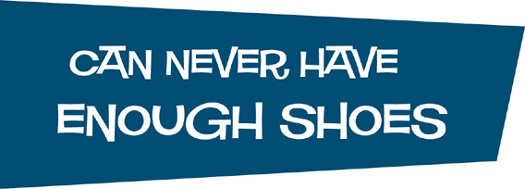
This pro-level shopper is having a great day in Palm Beach. Therefore, the store owners are having a fine day, too. She glances over at us, the viewer, with a knowing smile. This fun gesture works better than if I just turned her to face in the viewer’s direction. To do that would take away from her attractive and sly look. Her look should reflect that she’s aware that the viewer is looking at her.

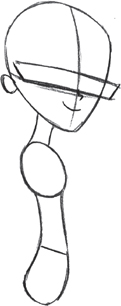
Make her head quite oversized.

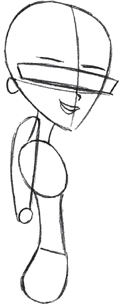
Raise her shoulders way up to create an expression, giving the effect that she is glancing over her shoulder at something.


Pose the wrist for a feminine touch, or to make it look like she broke it while using a lathe. The “feminine touch” explanation is probably better.

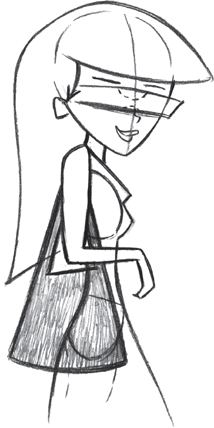
Make the purse straps narrow at her shoulder and then widen them out.
Note that there’s a little highlight on each lens of the sunglasses so that they don’t look opaque.

Here’s a friendly, somewhat goofy gal. She’s a versatile character. You can tweak her so that she becomes an older sister, or a college roommate, or a young mom, or even a super action hero. Well, maybe not quite that versatile.
Watch how her cartoony posture works like dominoes: Her head hangs forward, which causes her shoulders to slouch in poor posture, which causes her to stand with her feet pointed sideways, like a penguin, in order to maintain balance.


Notice that she’s mostly legs.
Draw a single, arching guideline to indicate which way the flat feet are drawn.


Add huge glasses to her modest-size head.
Remember that “skinny with big hips” is a funny character type.
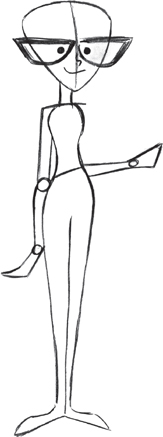
Make her arms lanky like the rest of her. By giving her zero arm fat, her elbow sticks out, for a humorous look.

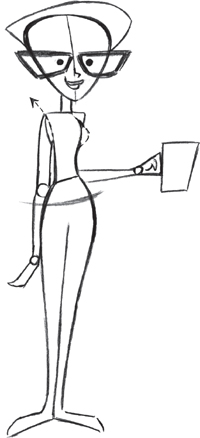
Note the curving line of the chest.
Add a second line below the line indicating the hips. This makes it appear that her pants are low on the waist and that she’s wearing a midriff.

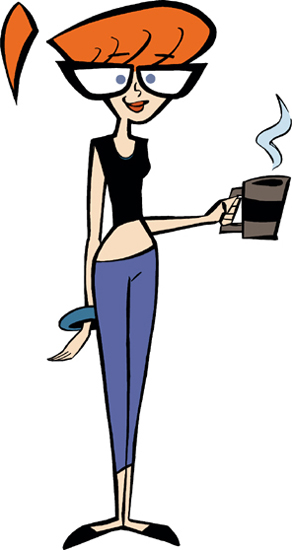
Because of her poor posture (her chest sinks in a bit, instead of curving out), her hanging arm is drawn behind, not in front of, her body.

Here’s an interesting character for you. She demonstrates several aspects of overlapping. The most obvious is the gift box she is carrying. Or, specifically, the arm that’s holding it. What about it? Many newer artists feel that it’s important to show both arms so that the viewer doesn’t see the image as flat. But just drawing the far hand, which is gripping the box is sufficient to give the illusion of depth.
You could also position the legs apart, to make it quite obvious that there are two of them. But they would then lose their sleek look. Oh, what to do? Just suggest depth with a small accent rather than by showing it overtly. Draw the far limb so it protrudes just a touch.


Notice how her eyes glance back, while her body faces forward.

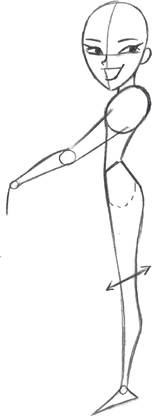
Show the shoulder and back mass behind her back; don’t just use a vertical line straight down from her neck.
Draw her skirt on a diagonal, which can be more stimulating than a horizontal line.
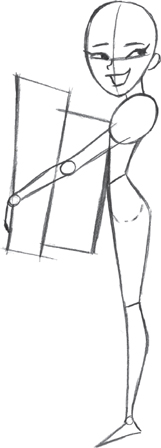
Leave some space between the object being held (box) and the body.
Even though the arms are outstretched, leave a tiny bend in them. This makes her look more lifelike.

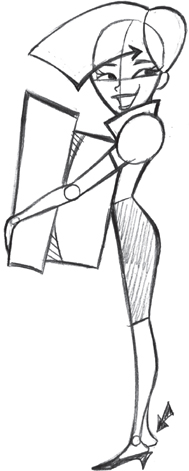
Add a shadow where one object overhangs another.
Hint at a second foot for a feeling of depth.
What makes this character’s body shape interesting? It’s the fluid nature of the line. As it works its way around the outline of the figure, it flows smoothly. It doesn’t pause or change angle as it goes from body section to body section. It just winds around them, like a wet noodle.

Redrawing, as well as doing additional drafts of the same character, is part of the process of cartooning. Redrawing is about more than repairing mistakes. It’s how you learn to embellish a character—to enhance its appearance and impact on the viewer.
Let’s start with the drawing from this page. Let’s say that, although you’re happy with this drawing, you’re not yet certain it’s a “keeper.” What do you do? Try tweaking it to see whether it improves or if the original version is best. You might want to take the initial drawing and enhance it by ratcheting up the character’s energy level and giving her a more specific action. For example, instead of simply holding a box full of what are presumably clothes, handbags, or boots, tweak the character so that she’s attempting to conceal them from her husband. But he finds out anyway. And they get into an argument. But she wins. How come I can never be the one who wins?
Use moderation when tweaking a character, and when eating potato chips. I’m certain about this approach in both cases. If you overdraw the character, you won’t have different versions of the same drawing to choose from but different drawings, period. With this approach, you’re looking for new versions, not new characters.
Hold the box behind, instead of in front of, the body.
Place one leg up with the toes pointed to create a coy look.
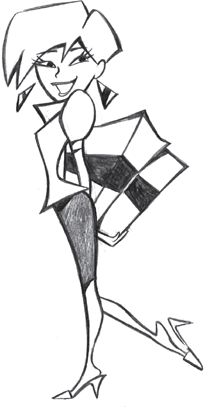
Look at the curved outline here on this normal back.

Compare the lines of this figure, which are playful, with the ones on the normal back, which is passive.
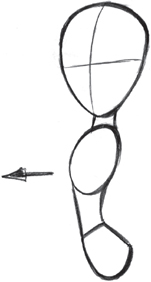
Note how the chest pushes forward to counterbalance the curve of the lower back.
Here are a few notes to help you give the character the final touches that make her sparkle.
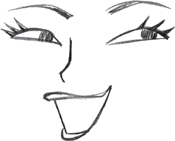
Pretty eyes don’t always have to be large. Sometimes you can make them squint to highlight the character’s weapons-grade eyelashes.

Make her upper lip go straight across. Create her smile with the curve of the bottom lip.
Female feet are all about graceful lines. That, and Prada.
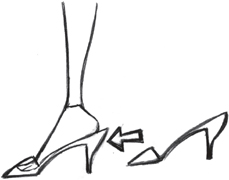
Don’t forget that the foot and the shoe are two different shapes.
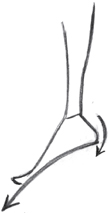
Use a long, sweeping arch for the shape of the foot in high heels.

Study the basic foundation and angle of the female foot.
NOW THAT I’VE SHOWN YOU HOW YOU CAN TAKE A FINISHED DRAWING AND BUMP IT UP ANOTHER NOTCH, LET’S TAKE A QUICK LOOK AT SOMETHING NOT TOO MANY HAVE THE OPPORTUNITY TO SEE: SOME FIRST-DRAFT SKETCHES THAT ARE EARLY VERSIONS OF A CHARACTER. WHY AM I SHOWING THIS TO YOU? BECAUSE I AM RUNNING LOW ON MY PAGE COUNT? OH, YOU ARE A SKEPTICAL ONE, BUT NO. THE REASON I OFFER THESE EXAMPLES IS TO SHOW YOU JUST HOW MESSY REDRAWING CAN BE. THE PROCESS OF SEARCHING FOR THE RIGHT FORM IS NOT THE TIME TO TRY TO DRAW PERFECTLY OR TO SELF-EDIT. THAT COMES AT THE CLEANUP STAGE. BEGINNERS USUALLY CONFLATE THE TWO, AND AS A RESULT, IT OFTEN DOESN’T WORK OUT THAT WELL. IN FACT, IT CAN LEAD TO DISASTER. OR, AT LEAST, THE DRAWING MIGHT NOT BE AS GOOD AS IT OTHERWISE COULD. WHICH IS, AS I SAID, A DISASTER.